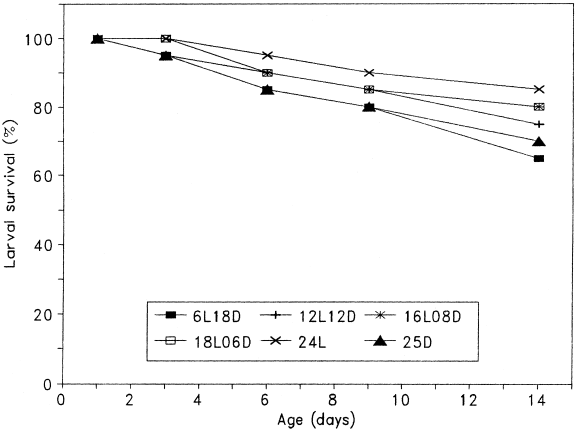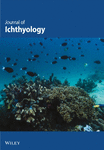Effect of light periodicity and intensity on the growth and survival of Heterobranchus longifilis Val. 1840 (Teleostei: Clariidae) larvae after 14 days of rearing
Abstract
Heterobranchus longifilis Val. 1840 larvae were reared under two light intensities, 30 lux and 915 lux, and at varying photoperiods. Results show that maximum survival (82.5 ± 6.5% respectively) at 30 lux was obtained at continuous illumination [24 h light (L)], while the minimum (65 ± 21.2%) was at the 6 h L : 18 h dark (D) treatment. Survival at 24 h D averaged 71.3 ± 6.3%, with no significant difference (P < 0.05) in growth of larvae. Maximum larval survival at 915 lux was 87.5 ± 17.7% at the 18 h L treatment. Growth was not significantly different (P < 0.05) in the treatments. Comparison of the two light intensities showed that survival was better at a photoperiod above 12 h irrespective of intensity, while growth was significantly better at the 915 lux intensity.
Introduction
Photoperiod and light intensity requirements of fish are species-specific and vary for the various developmental stages. Cerqueira (1991) hold that many fish larvae are diurnal, Huang (1991) are of the view that teleosts are most active at dawn and dusk. Evidently, light plays a major role in regulating fish larval activity (e.g. feeding). Prey selection and localization by fish is highly dependent upon light intensity, periodicity, and the contrast between prey and environment, especially in species classified as ‘visual predators’ ( Blaxter 1980). Photoperiod not only limits searching time but also can stimulate growth ( Brett 1979). Growth and rate of ingestion are maximized at certain ranges of light intensity ( Gulbrandsen 1991).
Heterobranchus longifilis Val. 1840 adults are known to exhibit the scotophilic circadian rhythm, obtaining about 70% of their food at dark periods ( Avit 1995 ; Boujard 1996) . However, the feeding habit of H. longifilis larvae in relation to light is seldom reported in the literature. This paper describes the impact of the photoperiod on growth and survival of H. longifilis larvae under two light intensities.
Materials and methods
One-day-old H. longifilis larvae (mean length = 5.0 ± 0.67 mm, n = 21) were stocked in 8 L aquaria (water volume 2 L, depth 4 cm) at a density of 20 individuals per aquarium. Each experiment had four replicates except the 16 h L and 18 h L at 915 lux which had two replicates each.
Light intensity was measured at the aquaria water surface using a Model 23AM300 photometer. Temperature was as the ambient (27 °C). The treatments at 30 lux were 6 h L : 18 h D; 12 h L : 12 h D; 16 h L : 8 h D; 18 h L : 6 h D; 24 h L; the light source was a 36 W Day Light fluorescent tube (length 4 ft), placed 2 m above the aquaria. Tests at 915 lux included 12 h L : 12 h D; 16 h L : 8 h D; 18 h L : 6 h D; the light source was two 36 W fluorescent tubes placed 30 cm vertically from the aquaria. There was also a 24 h D test set-up in a room where only minimal brightness was allowed during cleaning and taking measurements, which lasted 3 min.
Larvae were fed thrice daily with live zooplankton obtained from a mixed culture in concrete tanks. The zooplankton consisted of rotifers (Asplancha priodonta, 30%Brachionus plicatilis, 13%Brachionus quandridentatus, 21%), Cladocera (Alona monachanta, 15%), Ostracod (Cypria mediana, 12%), and Copepod (Diaptomus sicilis, 9%). The number per ml was obtained by counting under the phase contrast microscope using methodology from Ajah (1995).
Dead fish and debris were siphoned daily, but the larvae were not replaced. Culture containers were screened with dark polythene to enhance prey encounter according to Blaxter (1980). The oxygen concentration was measured with an oxygen meter and remained above 5 mg L−1 through aeration using an air-blower (diffuser aerators) and air-stones.
Prior to the end of the experiment, records of survival were taken at 3 day intervals. Individual lengths and survival were recorded in all replicates and the data were pooled for analysis at the end of the 14 day experiment.
Statistical analysis was carried out using the Analysis of Variance ( anova) at a level of ± = 0.05. All percentages were transformed using the arcsine prior to analysis of variance ( Sokal 1995) . Where ANOVA indicated significant difference, the Student Neumann-Kuels (SNK) test was carried out to separate means.
Results
Larval survival was maximum (82.5 ± 6.5%) at a continuous illumination (24 h L) of 30 lux, while minimum survival (65 ± 21.2%) was recorded at 6 h L. At 915 lux, survival was highest (87.5 ± 17.7%) at 16 h L : 8 h D, and lowest (55 ± 21.2) at 18 h L : 6 h D. Larval survival (71.3 ± 6.3%) recorded at 24 h D revealed that H. longifilis larvae fed in the dark. Significant differences (P < 0.05) existed among the various treatments at 30 lux and 24 h D, with the maximum at 24 h L, followed by 12 h L : 12 h D, 24 h D and 6 h L : 18 h D, in that order ( Table 1). There was no significant difference in survival between larvae reared at 24 h L, 18 h L and 16 h L. The relationship between survival and age of larvae at 30 lux is presented in Fig. 1.


Relationship between survival and age of H. longfilis larvae at 30 lux light intensity and different photoperiod (L, light hours; D, dark hours)
Growth (in length) at 30 lux showed no significant difference (P < 0.05), although absolute values indicated better growth under continuous illumination ( Table 1). At 915 lux, growth was better at the 18 h L treatment (17.3 ± 0.9 mm, n = 22) than at 16 h L (16.3 ± 0.7 mm, n = 35) or 12 h L (14.5 ± 0.4 mm, n = 56).
A comparison of the corresponding photoperiod at the two light intensities showed that growth was better at 915 lux, while survival was similar (P < 0.05). Only similar light intensities were compared here.
Discussion
The results ( Table 1) indicate that survival of H. longifilis larvae is enhanced by increased day length. Hence, the continuous illumination at 30 lux, and 16 h illumination at 915 lux, gave maximum survival. This indicates that H. longifilis larvae are visual hunters. However, the growth and survival of the larvae in darkness show that H. longifilis larvae are not obligate visual predators and, as such, may feed and grow well in the absence of light. This could point to the adaptability of the species to the turbid water that characterizes the floodplains during the season of its natural reproduction ( Teugels 1990) . It is then possible that H. longifilis larvae recognize and select their prey both visually and with their barbels. In the absence of light, the barbels obviously are quite adequate for prey recognition and selection. The implication for aquaculture of larval growth and survival in darkness is that the feeding of H. longifilis larvae does not necessarily depend on mobile stimulus through the prey, suggesting the possibility of rearing the larvae on commercial food. Species that only visually recognize their prey depend on movement of the prey, and may not accept formulated feed. Since survival increased with increased daylength (except for the 18 h L : 6 h D at 915 lux), H. longifilis larvae obtain most of their food in the presence of light, in contrast with the adults which are predominantly nocturnal feeders ( Avit & Luquet 1995; Boujard & Luquet 1996). This fact is further underlined by the reduced survival at 24 h D and 6 h L : 18 h D treatments ( Table 1). However, survival generally decreased with time for all treatments as is shown in Fig. 1.
The good growth at 915 lux could be attributed to the endocrine-stimulating effect of light ( Brett 1979). However, at 30 lux, growth was not improved by increased day length, suggesting that intensity could be necessary for endocrine stimulation, in agreement with Gulbrandsen (1991) that fish larvae may maximize their rates of ingestion and growth at certain ranges of light intensity. Also, feeding at an increased light intensity could result in a higher food intake due to improved visibility ( Gulbrandsen 1991).
The response of H. longifilis larvae to different light periodicity and intensity is in contrast Page (1975), who found no growth differences in channel catfish in response to light intensity and periodicity, and is in confirmation with Blaxter (1980) that the influence of light on fish larvae is species specific. In addition, H. longifilis larvae fed and grew well at low intensity and absence of light, contradicting the notion that feeding drops off rapidly as light levels decrease. In other words, the feeding activity of H. longifilis larvae does not depend on optical stimuli.
The growth and survival of H. longifilis larvae could be improved at continuous illumination and intensity not higher than 915 lux. It is therefore recommended that hatcheries where H. longifilis is cultured should maintain a light regime of at least 12 h at an intensity not lower than 30 lux.
Acknowledgements
The hatchery facility used for this research was funded by the EEC. We also thank Mr R. Rahe and Professor A. I. Obiekezie for their criticisms.




